What is the down screen in basketball
The down screen consists of basketball action that occurs when one offensive player faces the general direction of the baseline to set a screen on a defender who is guarding a second offensive player. Following that, the second offensive player can then use the down screen to get open for a possible scoring or playmaking opportunity.
Also, the down screen is usually one of the more common types of off-ball basketball screens that is implemented within various types of basketball offense strategies.
In addition to that, there are two variations of the standard down screen, known as the pin down screen and the wide pin down screen, respectively.
What is the pin down screen
The pin down screen is a type of down screen that is typically set near or within the lane at an angle towards the basket.
The pin down screen is generally utilized to help an offensive player get open, especially to take a mid-range or three-point jump shot near the perimeter areas of the court.
The pin down screen could also be used in conjunction with an offensive set, generally known as floppy action or a floppy screen.
Essentially, with the floppy action, an offensive player gets in position near or under the basket and then that same offensive player can cut off a single pin down screen set near the side of one particular lane line or a double screen, which is usually a stagger screen, set near the side of the opposite lane line.
What is the wide pin down screen
The wide pin down screen is a type of down screen and a sub-variation of the basic pin-down screen, typically set near the baseline at an angle towards the corner.
Similar to the basic pin down screen set near the basket, the wide pin down screen set near the corner could also be implemented to create open space near the perimeter areas of the court for a mid-range or three-point shooter.
However, the wide pin down screen is different from the basic pin down screen because the wide pin down screen could also be used to create scoring opportunities near the rim, primarily via the curl cut or slip action.
For example, let’s say that there are three offensive players, denoted as player A, player B, and player C who are near the top, right side corner, and left side wing, respectively.
Additionally, let’s say that player C, near the left side wing has possession of the ball as well.
From that point, let’s further say that these three offensive players are currently being guarded, particularly with man to man defense, by three defenders, indicated as defender A, defender B, and defender C, respectively.
Moreover, let’s say that player A near the top cuts through to set a wide pin down screen for player B, who is currently positioned in the corner.
Next, let’s say that player B initially plans to use the wide pin down screen to cut towards the top and receive the ball from player C for a possible three-point jump shot.
However, let’s say that defender B goes under the screen that is set for player B in an attempt to prevent player B from getting open near the perimeter.
When that happens, player B could then counter that defensive action by executing a curl cut to the rim via the wide pin down screen.
After that, player B could receive the ball from player C and score near the basket.
As another example with similar initial action, let’s say that player B would like to use a wide pin down screen of player A.
However, during the screening action, defender A and defender B decide to execute a defensive switch in an attempt to completely diminish the effectiveness of the down screen.
When that occurs, player A, who initially set the screen could slip to the basket before defender B is able to fully switch.
As a result, player A could receive the ball from player C and score at the rim with a layup or dunk.
Furthermore, the wide pin down screen could be implemented as a tactic to occupy the help defense on the weak side of the court or it could be used alongside additional offensive execution such as dribble handoff action.
What can a defender do to potentially limit the down screen
A defender can jam the screen cutter, go under the down screen, or simply switch with the screener’s defender, to potentially limit the effectiveness of the down screen.
Jam the screen cutter
Essentially, when an offensive player executes a basketball cut to get open via the down screen, that same player should generally have their inside shoulder as close as possible to the outside shoulder of the screener.
When the two offensive players involved in the down screen stay shoulder to shoulder, the defender who is the target of the screen is more or less forced to fight over the top of it or go under it, especially if that defender was initially chasing behind their offensive assignment.
As a result of that, the offensive player who used the screen would typically have at least a moderate amount of open space, even if that same player is only open for a second.
However, the defender who is the target of the down screen could mitigate or totally prevent the effectiveness of the screen by standing in the gap between the inside shoulder of their assignment and the outside shoulder of the screener, prior to the occurrence of the screening action.
In other words, if the defender who would be the target of a down screen is able to stay in front of the inside shoulder of the offensive player that they are currently guarding, then the down screen would be limited or totally ineffective.
Basically, when the defender is able to jam the screen cutter in this manner, this means that the screener and the cutter cannot get shoulder to shoulder with any noteworthy effect.
As a result, the defender executing the jam action does not have to fight through or go under the screen, which, in turn, eliminates potential open space for a possible jump shot or additional playmaking opportunity for the offensive player using the screen.
It should be also mentioned that an offensive player could possibly counter the defensive jam action with a backdoor cut or curl cut, particularly if there is open space in the lane.
In other words, the offensive player being jammed would essentially stop cutting towards the perimeter but counter by cutting towards the basket.
The offensive team could also utilize the floppy action as another type of counter to mitigate the jam action as well.
In that instance, an offensive player would cut towards the perimeter by way of a single or double screen and more specifically, the offensive player would cut to the perimeter via the screen in the direction that is opposite the defensive jam.
Related: Jamming an Offensive Player Using a Screen – YouTube
Go under the down screen
If the defender does not jam the screen cutter and is essentially chasing behind the cutter, then the defender could possibly close the open space between themselves and the cutter by going under the screen, which is also known as shooting the gap, in this instance.
By going under the down screen, the defender could potentially limit scoring or dribble penetration opportunities for the offensive player that utilizes the screen.
However, it should also be stated that an offensive player could counter with a fade cut if the defensive player decides to go under the down screen.
To give a brief example of that, let’s say that an offensive player initially desires to cut towards the right side slot after using a down screen but the defender guarding that same offensive player goes under the screen.
From that point, the offensive player could counter by simply changing the direction of their cut from the right side slot to the right side wing, or perhaps the right side corner.
When that occurs, the defender would probably not have enough time to execute a proper defensive closeout, which could then lead to an open jump shot or additional playmaking opportunities.
Switch during the down screen action
In certain instances, the defender who is the target of the down screen and the screener’s defender could execute a defensive switch to mitigate the effectiveness of the down screen.
In other words, the defender who is being targeted by the down screen would not even attempt to jam the screen cutter or go under the down screen.
Instead, the screener’s defender would simply switch to guard the offensive player that used the down screen while the initial target of the down screen switches to guard the screener.
This could be highly effective if the two defenders involved in the switching action are versatile defenders that can guard multiple basketball positions.
However, it should be noted as well that an offensive player utilizing the screen could counter the switching action by setting a down screen themselves, particularly on the screener’s defender.
Afterwards, the screener could use that secondary down screen and take a potential jump shot or, the two players involved in the screening action could execute offensive measures such as dribble handoffs to generate scoring opportunities.
What are examples of simple basketball plays that use the down screen
Example 1
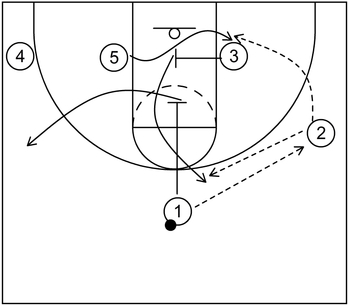
This is an example of a basketball play that features screen the screener action by way of a cross screen and a standard down screen.
To begin, 2 receives the ball from 1 and after that, 5 cuts to the right side low post block, by way of the cross screen set by 3.
Next, 3 cuts to the top via the standard down screen set by 1 to complete the screen the screener action. From there, 3 could receive the ball and take the jump shot quickly if that is open.
Alternatively, 5 could receive the ball and score near the basket, particularly with a low post move.
Also, if 5 receives the ball, then 1 could cut towards the left side wing. However, if 3 receives the ball and takes the jump shot, then 1 is in a great position to get a potential offensive rebound.
Example 2
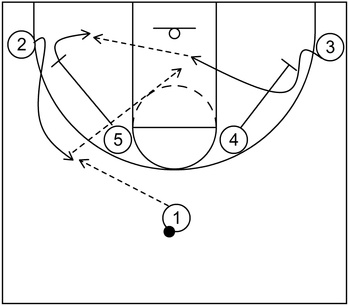
This is an example of a basketball play from the Horns offense that utilizes wide pin down screens on both sides of the floor.
To start, 2 cuts to the left side wing area via the wide pin down screen set by 5. Following that, 2 receives the ball from 1. Next, 3 executes a curl cut to the basket by way of the wide pin down screen set by 4.
From there, 3 could receive the ball from 4 and score at the rim with a layup or dunk. Also, if the defender who is guarding were to slide into the lane to protect the basket, then 5 could pop to the short corner, receive the ball from 3, and take the mid-range jump shot.
Example 3
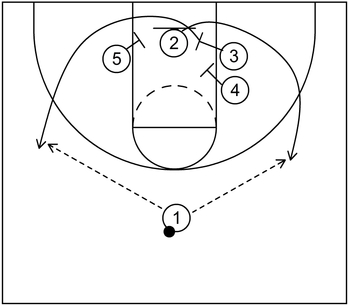
This is an example of a basketball play that demonstrates the basic floppy action with a single pin down screen on one side of the court and stagger screens on the other side. This type of action is also known as a single/double screen or a single/double offense.
During the initial setup, 2 begins underneath the basket and has the option to pick either side of the screens. In this case, 2 cuts to the right side wing via the screens set by 3 and 4.
Doing that gives 3 the opportunity to cut to the left side wing by way of the screen set by 5, which is also screen the screener action as well. From that point, 2 or 3 could receive the ball from 1 and take jump shots if those are open.
Affiliate Disclosure: I may earn a commission on qualifying purchases made through the links below.
What are examples of basketball drills that incorporate the down screen
These are examples of basketball drills that seek to increase players’ skills in utilizing the down screen.
Also, for these examples, numbers are used for demonstration purposes and are not necessarily representative of standard basketball positions. In other words, player 1 does not necessarily need to be the team’s point guard or player 5 is not required to be the team’s center.
Example 1
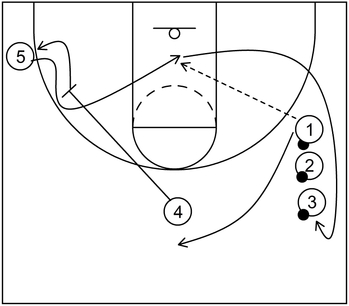
This is an example of a basketball drill that implements the wide pin down screen followed by a curl cut.
It is based on insights within Developing Interchangeable Perimeter & Post Players by Matt Painter.
The drill is set up with two or more players, each in possession of the basketball, near the right side wing and those same players will pass the ball to the cutting player.
Additionally, one or more players are at the top that will set the screen and one or more players are near the left side corner that will cut to the basket.
To begin, 4 cuts toward the left side corner to set a wide pin down screen for 5. Next, 5 uses that screen and executes a curl cut to the basket. After that, 5 could receive the ball from 1 and score at the rim with a layup or dunk.
To continue the drill, 5 would get the ball out of the basket ring after scoring and then, sprint to the back of the passing line near the right side wing.
Also, 4 would fill the vacant area near the left side corner and become the new cutter. Moreover, 1 would cut to the back of the line at the top and become the new screener.
Example 2
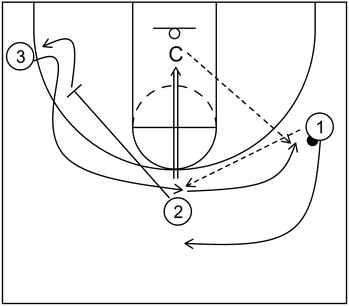
This is an example of a basketball drill that uses the wide pin down screen followed by a cut to the top.
The drill is set up with one or more players near the right side wing that will pass the ball, one or more players near the top that will set the screen, and one or more players near the left side corner that will cut to the top for a jump shot.
Additionally, there is at least one coach (or perhaps one or more additional players or team managers), indicated by the letter C, near the basket that will rebound made shots or missed shots and then, pass the ball to the players near the right side wing.
To begin, 2 cuts toward the left side corner to set a wide pin down screen for 3. Following that, 3 uses the screen and cuts to the top to receive the ball from 1.
Afterwards, 3 takes the three-point jump shot as shown on the diagram. However, it should also be noted that 3 could take a mid-range shot as well, particularly if the three-point shot is out of range.
Next, the coach gets the rebound and as that occurs, players will move to new areas of the court. 1 cuts to the back of the line at the top and becomes the new screener.
Also, 2 fills the vacant spot in the left side corner and becomes the new shooter. Furthermore, 3 shifts to the right side wing, receives the ball from the coach, and becomes the new passer.